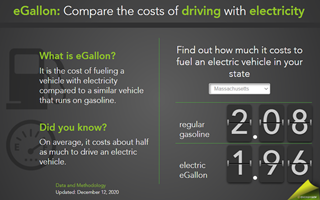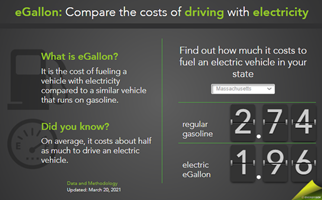 It’s all over the news: gas prices have hit a seven-year high. Depending on your political beliefs, you might blame inflation or the president. But the largest factor driving petroleum prices is simply supply and demand.
It’s all over the news: gas prices have hit a seven-year high. Depending on your political beliefs, you might blame inflation or the president. But the largest factor driving petroleum prices is simply supply and demand.
Fossil fuel consumption went down last year due to the pandemic, and so did production. Now that the economy is reopened, demand is back up, supply is constrained, so prices are higher. Regardless of the underlying cause, many drivers are unhappy to be paying nearly $1.50 more at the pump than they were a year ago. As a consumer advocacy organization, we have to draw attention to the growing group who are managing to keep their fuel costs consistent: electric vehicle (EV) drivers.
Since 2016, our Drive Green program has helped drivers make the switch to an electric vehicle. It’s better for the climate, and just as importantly, driving on electricity saves consumers money because EVs are more efficient (in other words, they consume less energy) and electricity is less expensive than gasoline. Many people undercount the scale of savings that come from switching to an EV. Even in Massachusetts and Rhode Island, which have some of the highest electricity rates in the country, EV drivers save roughly $555 annually compared to gas drivers. However, those who drive more save more, and savings increase when gas is more expensive.
The fuel savings benefits of switching to an EV can be hard to see because it’s tricky to compare per-gallon gas costs to per-kilowatt-hour electricity costs. An easy way to make the comparison is using the Department of Energy’s e-gallon calculator, which converts the cost of electricity to a value you can compare to the cost of a gallon of gasoline.


In the images above, the prices on the left are from December 2020 and the prices on the right are from March 2021. The cost of fueling an EV in Massachusetts is equivalent to paying $1.96 a gallon. Note that electricity prices stayed consistent, whereas gas prices shifted significantly. Even at the height of COVID-19 lockdowns in the spring of 2020, when gas prices dropped to $2 a gallon, EVs were still less expensive to fuel on a per mile basis. Now that gas prices are on the rise, EV drivers are saving more.
The price volatility of gasoline is not new. Gas prices are constantly shifting up and down because gasoline is vulnerable to global shifts in the oil market. By comparison, electricity generation is heavily regulated, which means that consumers are protected from big price swings.
The frustration of fluctuating gas prices is a great reason to consider an EV, on top of the climate and health benefits. Of course, since a lot of New England's electricity comes from natural gas, the price volatility of fossil fuels will affect electricity prices, too. In a previous blog on energy costs this winter, we estimated that rate hikes by National Grid will increase electricity by 2.4 cents per kilowatt-hour. That translates to $2.06 per e-gallon.
For an EV driver who travels 40 miles a day, that amounts to roughly $8 more per month paid to fuel their vehicle compared to the $60 extra the same driver would pay to drive on gasoline under the current price spike. The EV driver also has the added benefit of knowing their fuel costs won’t rise any higher because the electricity rate can only be changed every six months and may have hit a peak this winter.
Stable fuel costs are just one benefit of driving an EV. If you're ready to ditch gasoline, visit greenenergyconsumers.org/drivegreen to learn more and start shopping for your next car.





Comments